Or, to put it as one of my readers/questioners did,
Why doesn't the Space Needle, a top-heavy skyscraper, ever tip over and fall?
This is reasonable, and there's precedent for this. After all, the Leaning Tower of Pisa was falling over, and needed significant foundation-work just to keep it upright.
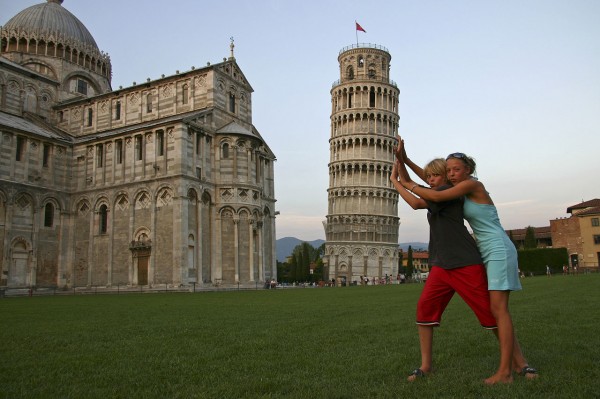
Now, when you take something like the Space Needle, it looks like most of the weight is in the top:
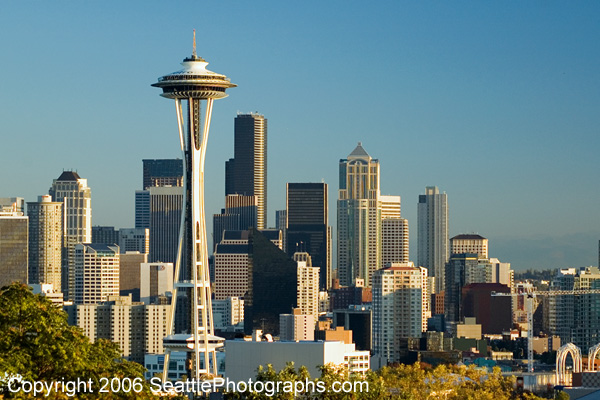
And it looks even more significant if you stand at the bottom and look up:

Yet, in actuality, the Space Needle is one of the most stable structures ever, and will be one of the last buildings standing in the event of a disastrous earthquake. How is this possible? It's pretty simple, and requires just one little physics concept: center of gravity. In a human being, your center of gravity is somewhere in your abdomen. The higher your center of gravity is above the floor, the tougher it is to balance. Riding a unicycle, for instance, is particularly difficult:
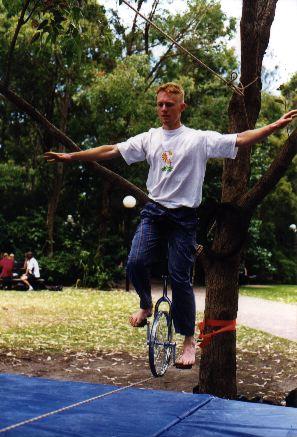
But, if you do something to tweak this, to lower the center of gravity, it becomes much easier to balance. The easiest case is if your center of gravity is below your floor. This makes it so easy that even an inanimate playmobile toy, if you put enough mass beneath the unicyclist's tightrope, will automatically balance:

Well, this is what they did when they built the Space Needle. They build, underground, a foundation so strong and so massive, that its center of gravity is actually beneath the ground! This is actually pretty straightforward to do if you can drill into some bedrock and sturdily anchor there.
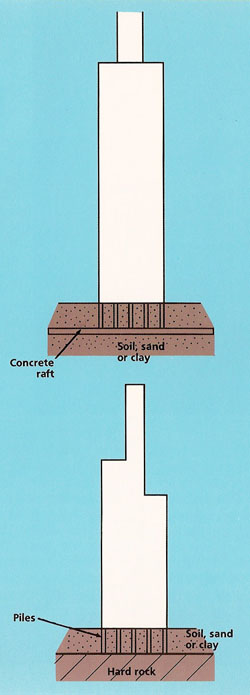
Why is this stable? Because if your building starts to tip, its foundation will rise, and therefore its center of gravity will rise. But this can't happen! Gravity pulls things down, and so Newton's simple laws (and the conservation of energy) forbid the Space Needle from tipping over so long as it stays anchored to its foundation.
Want to see a simpler example? Simply head out to your local public body of water, and look for a buoy.
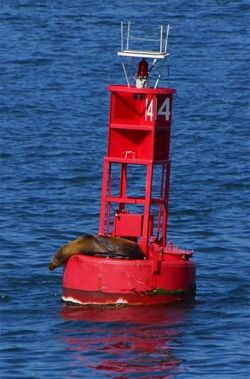
Know why these things stay upright? Because their center of gravity is below the surface of the water. If you tipped one, its center of gravity would rise, which is forbidden. Buoys actually look like this:

So the only way to knock one over and have it stay overturned is to detach it from the foundation.
So, to conclude, this is the most important step in building a skyscraper: anchoring it firmly to a solid foundation. So long as the entire structure has its center of gravity below the ground, it will never topple. And that's why the Space Needle doesn't fall over, even though it looks like it's top-heavy.

Good explanation. It's hard for laypeople to get that sometimes. I'm a drafter, and deal with this in structures on a daily basis, and it sometimes still tricks me.
We built a concrete prison wall once that the client specifically asked to make it look like it was going to fall over (specifically, like it would fall inwards at any moment, to prevent prisoners wanting to come close to it). Using internal voids in a cantilevered top beam, the design team was able to come up with a design that was pretty convincing. So much so, that even though our guys in production had seen the drawings and I'd re-assured them repeatedly that it wasn't going to go anywhere, they still wouldn't walk on the side that was to be the interior side of the wall. The center of gravity of the entire structure was safely inside its footprint though, and it has been standing at a maximum security prison in Indiana for 6+ years now.
...which was just ONE reason every geologist I know went *facepalm* during 10.5...
(That, and when the Space Needle *does* fall over in that movie, its top lands on a spot a few miles away. Um.)
If one anchored a unicycle firmly to the ground, it would be just as stable as a skyscraper despite it's much higher center of gravity. Sure, you may argue that by attaching anything very firmly to the earth, you essentially relocate its center of gravity to the center of the earth. I find it hard to believe that the center of gravity of all the man-made parts of the Space Needle is indeed below ground. Is that really so?
That graphic's not very clear. What are the two diagrams of? Is the space needle attached to the concrete raft in the fist diagram, or hard rock in the second? Otherwise, good explanation.
I don't think the graphics necessarily represent the space needle's construction. However, judging from this page:
http://www.spaceneedle.com/discover/funfacts.html
the center of gravity is more than likely underground.
Excerpts:
Bottom of foundation: 30 feet below ground
The foundation weighs 5,850 tons and there are 250 tons of reinforcing steel alone (i.e., rebar) in the foundation. The Needle structure weighs 3,700 tons. [5850 tons below ground, 3700 tons above ground...I'd have to run some numbers with a bit more data (distance matters) to say so conclusively, but with this data, the CoG is almost certainly subterranean]
sorry for double post, but I thought of another point that matters...from that same link, you can see that the foundation is 120' square. Now, even if it weren't buried in the earth, that's one heck of a footprint. In order for a structure to tip over and fall down, the center of gravity of the entire structure has to be outside of the footprint of the structure. So even if the center of gravity were, say, 100' up in the air (130' above the bottom of the foundation), the structure would have to tip far enough that the center of gravity was outside of the base of the structure. Using my completely made-up number, that would require the structure to be at 24.8 degrees from vertical before tipping. Now, if you're more realistic, but still on the high side and assume the CoG is right at ground level, that would require the structure to be at 63.4 degrees from vertical before tipping.
The space needle is safe :)
I quite don't understand the part where you say if it is to tipped, the center of gravity will rise, which is forbidden. Why is it forbidden? You mentioned that gravity pulls objects downwards but I still don't see why is that forbidden.
I think Ethan just means that it is "forbidden" by the law of gravity. Just a figure of speech :)
@Sophos: I agree with you, it's not forbidden. The needle is a fairly rigid structure and pushing it over requires a lot of force - far more force than is supplied by the wind.
If an absolutely rigid structure were assumed and a force applied which actually shifted the needle by a small amount, when the force is removed the structure will move back to its upright position (assuming nothing else changed such as someone putting stones under the foundation each time it lifted - which it doesn't really do anyway).
The needle is not absolutely rigid though; the flexure is easily measured (you can even feel it move). So in reality we don't even have the opportunity to make it tilt by throwing pebbles under the foundation because it doesn't actually lift in a strong wind.
I think Ethan's main point was that even if you could push the tower over by a small amount, it is designed so that it would settle back into the same position once the force is removed. In reality though the needle doesn't shift, it flexes. Well, OK, it shifts as the continent drifts and it will shift as the rock below it shifts but that's just being pedantic.
Oops .. I forgot Ethan's comment about an earthquake. A really horrible earthquake could shift the foundation, but the needle still isn't going to fall over easily because it requires the top part to essentially outweigh the bottom part (via an external force) to tip it over - and that's really difficult (though not impossible) to do if the center of gravity is low. Of course there's the implicit assumption that the needle will not buckle in such a violent earthquake - but that condition will probably be met except when the frequency of the rocking is well matched to the needle's resonance frequency.
Thank you for your explanation. So the center of gravity is lowered when the pile is piled into the rock? So now the rock is considered part of the "weight" of the tower?
Like the example given, a buoy. If I were to apply a great force on the top, it would actually fall to the water and in a few seconds it would settle back into the same position. Am I right?
So if a violent earthquake is to strike, and assuming that none of the piles or the hard rock broke, the [ideal] tower MIGHT fall and hit the ground but then rise up back upright?
@Sophos
No. The reason a buoy rights can itself is that the water doesn't prevent the counter weight from sinking again. As the counterweight has a greater density then the rest of the buoy it is the part that will go down first.
That said you need an earthquake that is literally earth shattering to get the foundation of the Space Needle to shift in such a way that the tower can fall.
Some good questions in the comments, but most were in fact answered in the article.
Ethan Siegel did say that the only way to knock the Space Needle over (presumably intact) is to "detach it from its foundation". So if you want to consider just "the manmade parts", yes the center of mass is well above ground. But until the manmade parts are detached from their foundation, this makes as much sense as asking why the red parts of a car move the way they do--because they're connected to the rest of the car.
So looking at the structure as connected firmly to the Earth, it will not simply tip over as a victim of gravity, which was the original question ("Why doesn't the Space Needle, a top-heavy skyscraper, ever tip over and fall?"), not earthquakes or other amazing forces.
With all of that said, there are of course two ways to get the Space Needle to come crashing down--one is to detach it from its foundation, and the other is to cause a structural failure above the foundation.
Finally, the thing which was "forbidden" is this: for gravity to cause a mass to move upwards. Other forces come into play with earthquakes and hurrices, and so forth, but as far as "tipping over" and "falling down", gravity is our culprit, and it cannot cause a mass to rise against its own force, even for a moment.
@Sophos:
Not quite right. The space needle has a large poured concrete foundation (as others mentioned, ~40m square and ~10m thick) weighing almost 6000 tons (imperial ton, not metric); it is this huge weight that lowers the overall center of gravity. Anchoring into rock has a similar effect since the rock is essentially made part of the structure. Imagine those portable road signs that have a small concrete pad and a steel tube with a sign at the top - you can tilt them a little (and they do tilt in the wind) but they stand upright again when you stop pushing on them. If you push hard enough you can push the sign over of course. If an earthquake could make the needle lie on its side, it likely won't be coming upright again, but in such a situation you can bet Toronto will be a ghost town. Looking at the figures on the link that phreack provided, the center of gravity is likely to be above ground but low enough that the structure is extremely stable. Like the small portable signs, if you lie them on their side they won't pop back up but it does take some effort to push them to the point where they become unstable and fall.
With buoys it depends on the specific design; you can stand on some and with some effort you can 'overbalance' them but as soon as you get off they will become upright again. Many won't even tilt if you hang off of them because the weight is fairly large and a few meters below the buoy (a convenient trick which keeps them almost vertical even with high waves). I wouldn't recommend trying though; if it's a lighted buoy it's usually a criminal offence to be on them without permission. If you happen to see a research buoy you can try. :)
@sunkid: unless piers were sunk into the bedrock, looking at the needle's FAQ site I'd say the center of gravity is in fact above ground. However, the center of gravity is lower than half the length of the foundation and that makes it really difficult to tip something over. Imagine taking a shotput and using hollow aluminum rods to fasten it to the corners of a carboard base; make sure the center of the shotput is at a height lower than half the length of the cardboard base (make the base bigger if you want the shotput to be higher). You'll find it's not easy to tip over.
D'oh! Did I say Toronto? I meant Seattle. Hahaha - I'm confusing my needle structures - honestly, they all look the same to me.
To make the whole needle topple over you indeed need some massive force. To make it crumble all you need is some rusted steel reinforcement and enough force to put the concrete into tension instead of compression, say, a typical winter storm. So my biggest worry about earth quake damage would not be a total failure, but hairline cracks allowing nice salty coastal moisture to creep into the structure. The needle could be mortally wounded while being the only thing standing in all of Seattle.
In the early days of the Space Needle, they wrote songs about it tipping over. A quick search show several links to one I remember:
http://www.mudcat.org/thread.cfm?threadid=37720
http://www.themadmusicarchive.com/song_details.aspx?SongID=409
haha! They must have noticed all the traffic coming from this page. They've added the following line to their fun facts page:
The center of gravity for the Space Needle is 5 feet above the ground.
With that added bit of information, you can calculate that if the space needle were pulled up out of the ground, foundation and all (to remove the added forces of being attached to the ground), you'd still have to tip it over 60 degrees from vertical before it'd actually fall down.
No wind or earthquake is ever gonna do that without blowing the whole structure apart LONG before it gets to that point.
Thank you for all your reply and I especially like the example given by MadScientist; the portable road sign part.
Now my imagination is beginning to be wild. As for the portable road sign, if I apply a sudden force on its top, it will "swing" left then right and then left again and then right again until it gains its stability upright again. If I push and hold the sign, it may tilt. But the moment I slowly remove my hand, the sign stands upright again.
So my question is here: why can't I apply this theory to the needle? If a sudden great wind strikes the needle, it will sway left and right until it gains it stability, am I right? And if a giant lean against the needle, the needle would probably tilt to, say 45 degrees. But the moment the giant stands up again, the needle will get back to its original position, upright, just like the road sign, am I right?
Maybe a simpler question is: how far (to what angle) can the Needle tip before some structural element above ground fails, causing a cascade failure that brings the whole thing down? Surely it was not designed to withstand the stresses of more than a few degrees of tilt?
This keeps on reminding me of "Weebles wobble, but they don't fall down." Another center-of-gravity trick: cap your shampoo bottle before letting the air back in, which will squeeze the shampoo up in the bottle and raise its center of gravity. Then it will fall onto my feet in the shower every morning! (At least it does when my spouse does this).
Gary: a farmer was watching his cattle out in the pasture. a sudden earthquake hit and all the cows fell over--but the bull didn't. the farmer asked the bull why he didn't fall over too. the bull replied "we bulls wobble but we don't fall down."
The leaning tower of Pisa is good for business. If it was a standard straight tower would the tower have had so much fuss...
Read the full story here:
http://supermarketpeople.co.uk/archives/423
I'm still not clear on one thing from this article. Who the hot girl in the light blue dress is in the Leaning Tower photo? I just can't get her out of my head.
But in 14 years we don't have discussion to the center of gravity of the tilted top portion of the south tower. So why didn't it fall down the side?